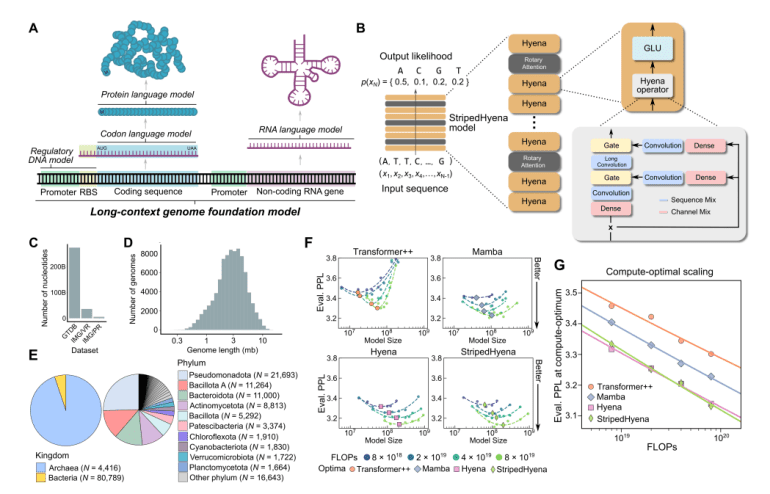- Genomic research delves into genome structures, functions, and evolution, crucial for biotech, medicine, and evolution studies.
- Evo, a groundbreaking genomic model, predicts and generates biological sequences from molecular to genome-scale levels.
- Evo’s deep signal processing architecture combines attention mechanisms and convolutional operators for precise sequencing analysis.
- Trained on vast prokaryotic genome datasets, Evo excels in predicting gene functionalities and generating complex biological systems.
- Evo outperforms existing models in zero-shot function prediction, gene essentiality prediction, and sequence generation tasks.
- Notable achievements include high correlations in fitness effects prediction and impressive AUROC scores for gene essentiality.
- Evo’s generative capabilities extend to crafting coherent CRISPR-Cas systems and diverse transposable elements.
Main AI News:
Genomic exploration stands as a pivotal domain delving into the intricacies of genome structures, functionalities, and evolutionary pathways. From dissecting DNA sequences to unraveling genetic variations, this field unravels the complex mechanisms dictating gene expression and regulation. Its ramifications span across biotechnology, medicine, and evolutionary studies, shedding light on genetic anomalies, prospective therapies, and the fundamental essence of life.
Addressing the pressing need for sophisticated models capable of predicting and generating biological sequences emerges as a paramount challenge. Present methodologies often fall short in complexity and scalability, hindering accurate genomic function modeling. Consequently, researchers are on a quest for precision-enhancing solutions, aiming to decipher and manipulate biological systems more effectively.
The quest for improved models persists, driven by the necessity to navigate the intricate web of genomic functionalities accurately. Traditional approaches predominantly rely on modality-specific models targeting proteins, regulatory DNA, or RNA. However, these models grapple with the complexity of multi-scale interactions inherent in biological processes. Moreover, their generative capacities are confined to simplistic molecules and brief sequences, lacking the breadth required for comprehensive genomic scrutiny.
Enter Evo, a cutting-edge genomic foundation model conceived by luminaries from Stanford University, Arc Institute, TogetherAI, CZ Biohub, and the University of California, Berkeley. Evo revolutionizes prediction and generation tasks, spanning from molecular intricacies to genome-scale phenomena. Powered by an innovative deep signal processing architecture, Evo boasts unparalleled precision in handling vast genomic datasets. Its architecture integrates a hybrid of attention mechanisms and convolutional operators, enabling seamless processing of sequences at single-nucleotide resolution across extensive contexts. Trained on a staggering 7 billion parameters, leveraging data from entire prokaryotic genomes, Evo transcends modalities, encompassing DNA, RNA, and protein realms. This versatility empowers Evo to forecast gene functionalities and orchestrate intricate biological systems with finesse.
Underpinning Evo’s prowess is the state-of-the-art deep signal processing architecture, StripedHyena. This architecture amalgamates attention mechanisms with convolutional operators, facilitating efficient processing of lengthy genomic sequences. By maintaining high resolution at the single-nucleotide level, Evo captures nuanced genetic variations with precision. Trained on a corpus of 300 billion nucleotide tokens extracted from bacterial and archaeal genomes, alongside millions of predicted phage and plasmid sequences, Evo deciphers the intricate tapestry of genomic patterns. The training regimen unfolds in two stages, initially employing a context length of 8,000 tokens and expanding to 131,000 tokens to encompass broader genomic vistas. Evo’s architecture, comprising 29 layers of data-controlled convolutional operators interspersed with multi-head attention layers and rotary position embeddings, augments its capacity to retrieve long-sequence information effectively.
Evo’s performance transcends boundaries in zero-shot function prediction and generation tasks. It engineers synthetic CRISPR-Cas molecular complexes and transposable systems effortlessly, attains pinpoint accuracy in gene essentiality prediction, and fabricates coding-rich sequences extending up to 650 kilobases. Notable performance metrics include a Spearman correlation of 0.64 for predicting fitness effects of mutations on 5S ribosomal RNA in E. coli, a correlation of 0.41 for mRNA expression prediction, and an AUROC of 0.68 for protein expression prediction. Evo’s prowess in gene essentiality prediction is underscored by AUROC scores of 0.86 for lambda phage and 0.81 for Pseudomonas aeruginosa. These achievements surpass the capabilities of existing domain-specific language models, underscoring Evo’s supremacy in diverse genomic tasks. Furthermore, Evo’s generative prowess shines through as it crafts coherent CRISPR-Cas systems, with a substantial percentage of generated sequences featuring Cas coding sequences spanning up to 5kb and generating transposable elements with notable protein sequence diversity.
Conclusion:
The introduction of Evo signifies a paradigm shift in genomic modeling, offering unprecedented precision and versatility in predicting and generating biological sequences. This innovation holds significant implications for industries reliant on genomic insights, such as pharmaceuticals, biotechnology, and agriculture, enabling accelerated research and development processes and potentially unlocking novel therapeutic interventions and agricultural advancements.

